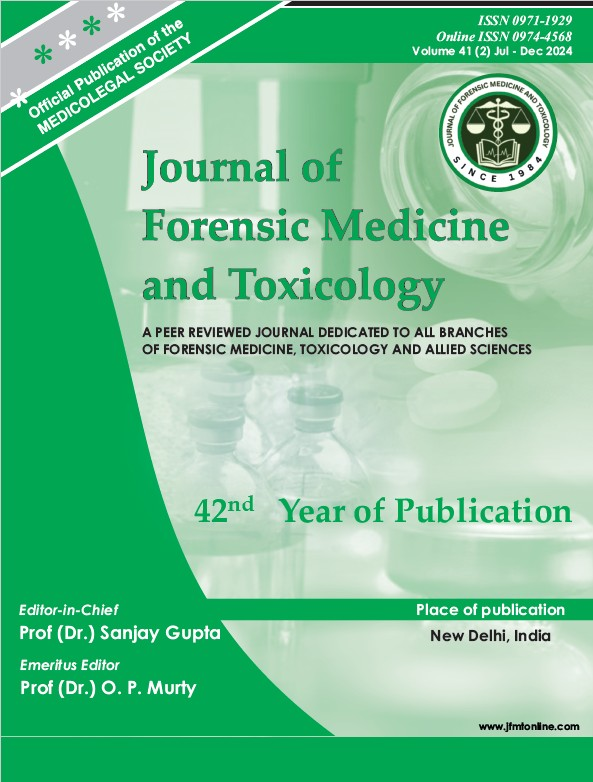SILENT SIGNS OF STRANGULATION: UNMASKING HIDDEN BRUISES IN A MANUAL STRANGULATION CASE
DOI:
https://doi.org/10.48165/jfmt.2024.41.1.28Keywords:
Manual Strangulation, Hidden Bruises, Silent Signs, Unmasking, Case ReportAbstract
Manual strangulation cases pose a unique challenge in forensic medicine due to the subtle nature of injuries, particularly concealed bruises that may go unnoticed during initial examinations. This case report aims to shed light on the often-overlooked signs of manual strangulation and the importance of meticulous forensic examination. We present a case involving a victim of manual strangulation where initial external examinations failed to reveal apparent signs of trauma. However, a detailed forensic analysis uncovered concealed bruises in unexpected locations, highlighting the elusive nature of injuries associated with manual strangulation. The victim’s delayed presentation further underscored the need for heightened clinical awareness and a multidisciplinary approach in such cases. Detailed documentation of the concealed bruises involved close collaboration between forensic experts, medical professionals, and law enforcement. Advanced imaging techniques, such as ultraviolet and infrared photography, played a crucial role in unmasking the hidden injuries. The case report discusses the challenges encountered during the investigation and emphasizes the importance of incorporating these innovative methods in forensic protocols. This case report underscores the significance of recognizing concealed bruises in manual strangulation cases, emphasizing the need for a comprehensive approach to forensic examinations. By raising awareness of the subtle signs associated with manual strangulation, this report aims to contribute to improved forensic practices and increased collaboration among experts in unraveling the silent but critical evidence that may be hidden beneath the surface.
Downloads
References
Glass NE, Laughon K, Campbell JC, Block CR, Hanson G, Sharps PW, et al. Non-fatal strangulation is an important risk factor for homicide of women. J Emerg Med. 2008;35(3):329-335.
Strack GB, McClane GE, Hawley D, Pless JE. A review of 300 attempted strangulation cases. Part I: Criminal legal issues. J Emerg Med. 2001;21(3):303-309.
Ralph DD, Heger AH, Scott M, Fuld D. The role of the physical examination in establishing the diagnosis of sexual abuse. Pediatr Clin North Am. 1990;37(4):845- 866.
Ramsbotham J. The role of the forensic physician in the assessment of non-fatal strangulation. Med Sci Law. 2018;58(4):202-208.
Logan BK, Couper FJ, Carfagna L. Deaths Due to Strangulation Associated With Sexual Assault in the United States: 2003-2007. J Forensic Sci. 2008;53(4): 885-888.
Petridou E, Kouri N, Kyrileis K, Dessypris N, Sfikas C, Trichopoulos D. Fatal domestic accidents among children in Greece. Inj Prev. 1996;2(4):260-263.
Gomez MP, Kercher J, Case ME. Positional asphyxia in adult forensic cases: an anthropological perspective. Am J Forensic Med Pathol. 1999;20(4):353-357.
Cham E, Guss D, Semienchuk EM, Wisner DH. Strangulation Victims in the Emergency Department. Ann Emerg Med. 2017;69(4):437-442.
DiMaio D, DiMaio VJ. Forensic pathology. CRC press; 2001 Jun 28..
Singh RR, Jha S, Mittal R, Tripathi SK, Kumari S, Yadav PK. Ethical Dilemmas in Emergency Anesthesia: A systematic review. International Medicine. 2023 Nov 3;9(3).
Singh RR, Bharti AK, Mittal R, Yadav PK. Forensic Nursing and Healthcare Investigations: A Systematic Review. International Medicine ISSN:. 2023 Nov 3;9(3).
Singh RR, Srivastava UK, Choudhary R, Yadav PK, Tripathi SK, Ttripathi SS. Impact of Overload on Emergency Medicine Department during Festive Season in a Tertiary Care Centre in North India: A Systematic Review. International Medicine. 2023 Nov 23;9(3).
Singh RR, Yadav PK, Yadav S. Management Strategies for Overcrowding in Emergency Medicine Department: A Narrative Review. Journal of Clinical and Diagnostic Research. 2023;17(8): OE05-OE09. https://doi.org/10.7860/JCDR/2023/61518.18333.




